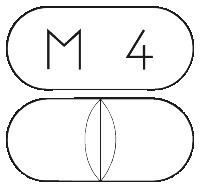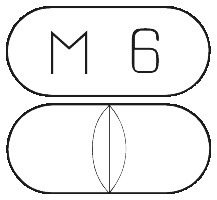What is in this leaflet
This leaflet answers some common questions about UROMITEXAN Tablets.
It does not contain all the available information.
It does not take the place of talking to your doctor or pharmacist.
All medicines have risks and benefits. Your doctor has weighed the risks of you taking UROMITEXAN Tablets against the benefits they expect it will have for you.
If you have any concerns about taking this medicine, ask your doctor or pharmacist.
Keep this leaflet with the medicine. You may need to read it again.
What UROMITEXAN Tablets is used for
UROMITEXAN Tablets is a protective agent which is used to prevent damage to your bladder and urinary system, that may be caused by some drugs used to treat cancer or auto-immune diseases. These drugs can cause a condition of the bladder, with pain in the bladder or back and blood in the urine. UROMITEXAN Tablets can help prevent this.
Your doctor may have prescribed UROMITEXAN Tablets for another reason. Ask your doctor if you have any questions about why UROMITEXAN Tablets has been prescribed for you.
Your doctor may decide to give you some of your doses in the form of UROMITEXAN Injection instead of UROMITEXAN Tablets. Both work just as well.
UROMITEXAN Tablets is not addictive.
This medicine is available only with a doctor's prescription.
Before you take UROMITEXAN Tablets
When you must not take it
Do not take UROMITEXAN Tablets if you have an allergy to UROMITEXAN Tablets or any related products (thiols), or to any of the ingredients listed at the end of this leaflet.
Symptoms of an allergic reaction to UROMITEXAN Tablets may include:
- shortness of breath, wheezing, difficulty breathing or a tight feeling in your chest
- swelling of the face, lips, tongue or other parts of the body
- rash, itching, hives or flushed, red skin
- dizziness or lightheadedness
- fast heart beat
Do not take UROMITEXAN Tablets after the expiry date printed on the pack. If you take this medicine after the expiry date has passed, it may not work as well.
Do not take UROMITEXAN Tablets if the packaging is torn or shows signs of tampering. If it has expired or is damaged, return it to your pharmacist for disposal.
If you are not sure whether you should start taking UROMITEXAN Tablets, talk to your doctor or pharmacist.
Before you start to take it
Tell your doctor or pharmacist if you have allergies to:
- any other medicines
- any other substances, such as foods, preservatives or dyes
Tell your doctor if you have or have had any medical conditions, especially the following:
- bladder problems
- auto-immune disease
Tell your doctor if you have had radiation therapy to the area of the pelvis. This could mean you need a higher dose of UROMITEXAN Tablets.
Tell your doctor about any other treatments that you have had for cancer, or are planned to have, such as other medicines, or radiation therapy. The doctor may need to alter the dose of UROMITEXAN Tablets or change to UROMITEXAN Injection.
Tell your doctor if you are pregnant or intend to become pregnant. Your doctor will discuss the risks and benefits of having your medicines during pregnancy.
Tell your doctor if you are breast-feeding or plan to breast-feed. It is not known whether UROMITEXAN passes into breast milk. There is also the possibility that the breast-fed baby may be affected by the anti-cancer medicines you are receiving.
If you have not told your doctor about any of the above, tell them before you start taking UROMITEXAN Tablets.
Taking other medicines
Tell your doctor or pharmacist if you are taking any other medicines, including any that you buy without a prescription from your pharmacy, supermarket or health food shop. It is possible that some medicines and UROMITEXAN Tablets may interfere with each other.
How to take UROMITEXAN Tablets
Follow all directions given to you by your doctor or pharmacist carefully. They may differ from the information contained in this leaflet.
How much to take
Your doctor or pharmacist will tell you how many tablets you will need to take, the time between doses and the length of time to take UROMITEXAN Tablets. This depends mainly on the dose of the anti-cancer medicines you are receiving, and other factors such as other treatments you have been given and any bladder.
If you do not understand the instructions on the box, ask your doctor or pharmacist for help.
How to take it
Swallow UROMITEXAN Tablets with a glass of water.
When to take it
UROMITEXAN Tablets is given before, during and for a few hours after each dose of your anti-cancer medicine.
Take UROMITEXAN Tablets at the exact times told to you by the doctor or pharmacist. If you do not take UROMITEXAN Tablets at the right times, it may not work.
How long to take it
Continue taking your medicine for as long as your doctor tells you. Your doctor will tell you when your treatment should be stopped.
If you forget to take it
If you have forgotten to take a dose of UROMITEXAN Tablets, take it as soon as you remember, and then go back to taking your medicine as scheduled. Contact your doctor or pharmacist immediately.
If you take too much (overdose)
Telephone your doctor or pharmacist if you think that you or anyone else may have taken too many UROMITEXAN Tablets. Do this even if there are no signs of discomfort or poisoning.
Symptoms of a UROMITEXAN Tablets overdose include the side effects listed below in the 'Side Effects' section, but are usually of a more severe nature.
While you are taking UROMITEXAN Tablets
Things you must do
Tell your doctor or nurse as soon as possible if you vomit while you are taking UROMITEXAN Tablets. You may need to change to UROMITEXAN Injection.
Be sure to keep all your doctor's appointments so your progress can be checked. Your doctor may want to check your urine and do some other tests from time to time to check on your progress and detect any unwanted side effects.
Be sure to follow your doctor's instructions about other medicines you should take, and other things you should do. The protective effect of UROMITEXAN Tablets applies only to the bladder and urinary system. You may still need to take additional medicines to protect other body systems.
Your doctor may also advise you to drink extra fluid while you are taking UROMITEXAN Tablets. This will help to prevent damage to your bladder and urinary system.
Ask your doctor or pharmacist if you have any questions.
Tell any other doctors, dentists, and pharmacists who are treating you that you are taking UROMITEXAN Tablets.
If you are about to be started on any new medicine, tell your doctor, dentist or pharmacist that you are taking UROMITEXAN Tablets.
If you become pregnant while taking UROMITEXAN Tablets, tell your doctor.
If you are having any tests on your urine such as for diabetic acidosis, tell your doctor or pharmacist that you are taking UROMITEXAN Tablets.
UROMITEXAN Tablets can interfere with some urine tests.
Things you must not do
Do not give UROMITEXAN Tablets to anyone else, even if they have the same condition as you.
Do not have UROMITEXAN Tablets to treat any other complaints unless your doctor or pharmacist tells you to.
Things to be careful of
Be careful driving or operating machinery until you know how UROMITEXAN Tablets affects you. As with many other medicines, UROMITEXAN Tablets may cause dizziness, light-headedness, and tiredness in some people. Make sure you know how you react to UROMITEXAN Tablets before you drive a car, operate machinery, or do anything else that could be dangerous if you are dizzy or light-headed. If this occurs do not drive. If you drink alcohol, dizziness or light-headedness may be worse.
Side effects
Tell your doctor, nurse or pharmacist as soon as possible if you do not feel well while you are taking UROMITEXAN Tablets. UROMITEXAN Tablets may have unwanted side effects. All medicines can have side effects. Sometimes they are serious, most of the time they are not. You may need medical treatment if you get some of the side effects.
Ask your doctor or pharmacist to answer any questions you may have.
Tell your doctor, nurse or pharmacist if you notice any of the following and they worry you:
- headache
- tiredness, sleepiness
- nausea, vomiting
- diarrhoea, soft stools
- wind
- constipation
- abdominal pain
- loss of appetite
- bad taste in the mouth
- fever
- chills, shivering
- flushing
- cough
- sore throat
- dizziness
- pain in the arms or legs
- pain in the back or joints
These are the more common or less serious side effects of UROMITEXAN Tablets.
If any of the following happen, tell your doctor or nurse immediately, or go to Accident and Emergency at your nearest hospital:
- Sudden life-threatening allergic reaction, with symptoms such as:
- shortness of breath, wheezing, fast breathing, difficulty breathing or a tight feeling in your chest
- swelling of the face, lips, tongue or other parts of the body
- rash, itching, hives or flushed, red skin
- conjunctivitis
- dizziness or light-headedness
- fast heart beat
- muscle pain
- bleeding or bruising more easily than normal
These allergic reactions occur more often in patients being treated for auto-immune diseases than in patients being treated for cancer.
These are very serious side effects. You may need urgent medical attention or hospitalisation.
Other side effects not listed above may occur in some patients. Tell your doctor, nurse or pharmacist if you notice anything that is making you feel unwell.
Do not be alarmed by this list of possible side effects. You may not experience any of them.
The benefits and side effects of UROMITEXAN Tablets may take some time to occur. Therefore even after you have finished your treatment with UROMITEXAN Tablets you should tell your doctor immediately if you notice any of the side effects listed in this section.
After taking UROMITEXAN Tablets
Storage
Keep your tablets in the pack until it is time to take them. If you take the tablets out of the pack they will not keep well.
Keep your tablets in a cool dry place where the temperature stays below 30 deg C.
Do not store UROMITEXAN Tablets or any other medicine in the bathroom or near a sink.
Do not leave it on a window sill or in the car on hot days. Heat and dampness can destroy some medicines.
Keep it where children cannot reach it. A locked cupboard at least one-and-a-half metres above the ground is a good place to store medicines.
Disposal
If your doctor or pharmacist tells you to stop taking UROMITEXAN Tablets, ask your pharmacist what to do with any that is left over.
Product description
What it looks like
UROMITEXAN Tablets are white, oblong, with rounded sides and a notch on one side. The 400mg tablet is marked "M4" and the 600mg tablet is marked "M6".
Ingredients
Active ingredients:
- mesna
Other ingredients
- lactose
- cellulose - microcrystalline
- calcium hydrogen phosphate
- starch - maize
- povidone
- magnesium stearate
- hypromellose
- macrogol 6000
- titanium dioxide E171
- simethicone
UROMITEXAN Tablets does not contain sucrose, gluten, tartrazine or any other azo dyes.
Sponsor
Baxter Healthcare Pty Limited
(ABN 43 000 392 781)
1 Baxter Drive
Old Toongabbie NSW 2146
UROMITEXAN Tablets is available in the following sizes:
400mg AUST R 56481
600mg AUST R 56482
Date of Preparation of this leaflet:
5 April 2006
UROMITEXAN is a trademark of Baxter Healthcare S.A.
Published by MIMS July 2006






